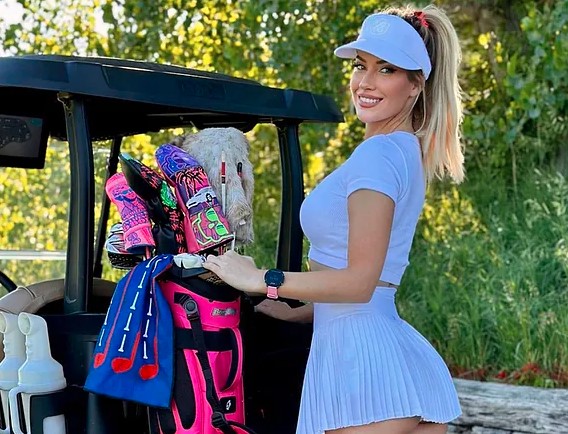Paige Spiranac, the social media sensation and golf influencer with millions of followers, has taken a swing at the PGA, calling out the organization for failing to compensate individuals who play a vital role in promoting the game to younger audiences. Known for her candid opinions and her efforts to grow the sport, Spiranac’s comments have sparked widespread discussion within the golf community.
The Critique That Rocked the Clubhouse
In a series of outspoken remarks, Spiranac criticized the PGA for leveraging influencers, creators, and grassroots ambassadors to market the game while offering no financial support. According to Spiranac, these individuals are pivotal in keeping golf relevant, especially among younger demographics who consume most of their content on platforms like Instagram, TikTok, and YouTube.
“They talk about growing the game,” Spiranac said, “but how do you expect to grow golf when the people actively bringing in new audiences aren’t valued? You can’t keep asking us to work for free while the sport profits from our efforts.”
The comments resonated with many who feel that the traditional golf establishment is slow to adapt to modern trends, especially in recognizing the power of digital media in shaping perceptions of the sport.
Spiranac’s Impact on Golf
Paige Spiranac, a former professional golfer, has become a trailblazer in using social media to make golf more accessible and appealing. With her engaging content, she has shattered the stereotype that golf is an exclusive sport for older, wealthy individuals.
Her influence is undeniable. By blending humor, instruction, and relatability, Spiranac has brought countless new players into the fold. Yet, her experience as an independent content creator has given her a unique perspective on the challenges of advocating for a sport that still clings to its conservative roots.
Spiranac’s efforts often involve breaking down barriers, from explaining golf’s often intimidating rules to addressing issues of diversity and inclusion within the sport. However, as she points out, this work often goes unrecognized—or worse, uncompensated.
The Role of Influencers in Modern Golf
In recent years, the PGA and other golf organizations have made efforts to attract younger audiences, recognizing that the sport needs fresh talent and fans to thrive. While traditional sponsorships and broadcast deals have been a cornerstone of golf’s financial model, the rise of digital platforms has shifted the marketing landscape.
Influencers like Spiranac are now key players in reaching younger audiences who might never tune in to a PGA broadcast or set foot on a golf course without first discovering the sport online.
“Golf influencers aren’t just promoting brands,” Spiranac explained. “We’re creating a gateway for people to fall in love with the game. That’s priceless for the future of golf, but it’s exhausting when that value isn’t recognized.”
The Bigger Picture: A Call for Change
Spiranac’s criticism raises broader questions about how traditional sports organizations compensate and collaborate with modern media figures. While professional golfers are paid for their performance, and commentators are paid for their analysis, influencers and grassroots ambassadors often fall into a gray area.
Many in the golf community agree with Spiranac’s sentiment. They argue that if the PGA and similar bodies are serious about “growing the game,” they must rethink their approach to partnerships.
One solution Spiranac suggested is creating official ambassador programs that provide influencers with resources, financial backing, and a platform to continue their work. “It’s not about the money,” she clarified. “It’s about respect and acknowledgment of the role we play in keeping golf alive.”
Fans and Followers Weigh In
The public reaction to Spiranac’s comments has been overwhelmingly supportive. On Twitter and Instagram, fans applauded her for speaking out, with many echoing her frustrations.
“She’s right,” one user commented. “Golf needs to evolve, and ignoring the people actually making it cool is a huge mistake.”
Others called on the PGA to rethink its strategy, emphasizing the need to embrace a modern marketing approach that leverages digital creators.
What’s Next for Golf’s Future?
Paige Spiranac’s outspoken nature has once again ignited a critical conversation. Her ability to blend traditional golf knowledge with modern-day appeal has proven invaluable to the sport. Now, the ball is in the PGA’s court to address the concerns she’s raised.
As golf continues to evolve, figures like Spiranac remind us that adapting to the times is not optional—it’s essential for survival. If the PGA wants to ensure a bright future, it may need to start by investing in the very people who are already doing the heavy lifting to bring the game to the next generation.
For now, Spiranac’s call to action serves as a rallying cry for those who believe that the future of golf lies not in tradition, but in transformation.







